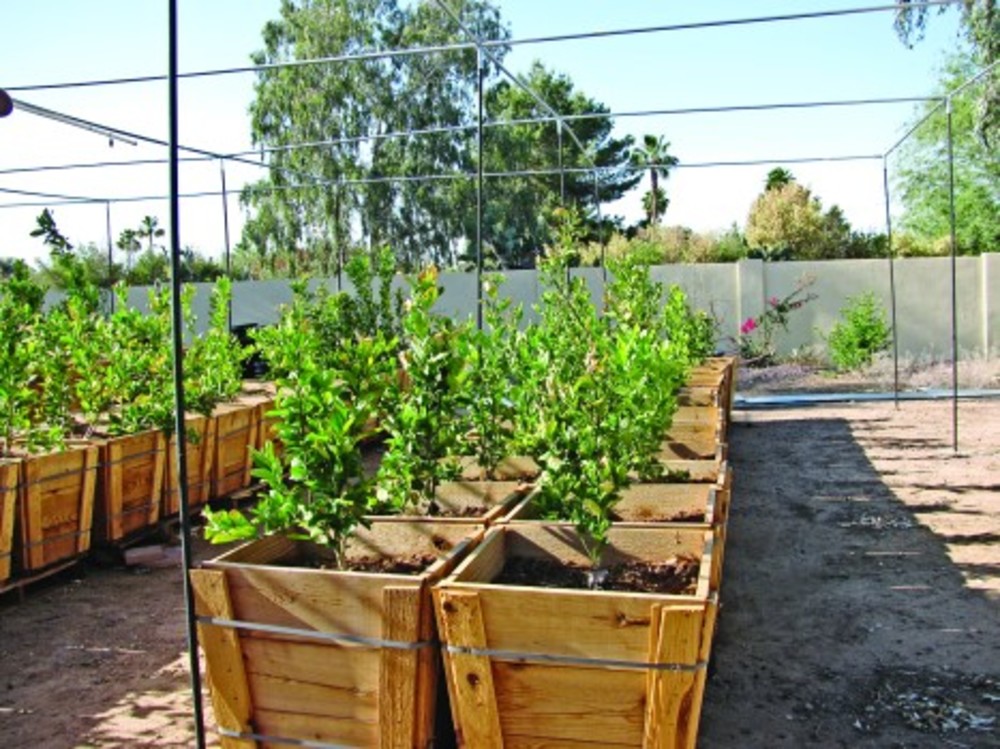The etrog orchard of Scottsdale
Brown grad grows the golden citrus in his backyard
 Rows of etrog plants in the Bycer backyard.I was recently in Phoenix, Arizona, for my son Jonathan’s graduation from Arizona State University. I had read about Matt Bycer’s etrog orchard in various Jewish magazines and wanted to see it. I had some extra time, so I arranged to pay him a visit.
Rows of etrog plants in the Bycer backyard.I was recently in Phoenix, Arizona, for my son Jonathan’s graduation from Arizona State University. I had read about Matt Bycer’s etrog orchard in various Jewish magazines and wanted to see it. I had some extra time, so I arranged to pay him a visit.
When I met Matt Bycer at his etrog orchard in Scottsdale, I immediately gave him a Rhode Island souvenir – a bottle of Eclipse coffee syrup. He thanked me, and, to my surprise, asked “Where is the Del’s?”
I never imagined there would be a Rhode Island connection. Matt told me he got his undergraduate degree from Brown in 2001, majoring in physics. He even taught Sunday school at Temple Emanu-El. He went on to law school at the University of Arizona in Tucson. He is now a practicing patent attorney. When he moved to Tucson he became observant, being influenced by Chabad. He also studied with Rabbi Jordan Brumer, who he followed from Tucson to the Phoenix area where the rabbi does outreach to college students.
But why grow etrogs? Matt told me he was concerned that there would be no good sources in the United States for etrogs during the Shmita year in Israel. That is the seventh year of the cycle in Israel when, according to Jewish law, fields must lie fallow.
When I walked into Matt’s backyard, it was not what I had expected. Having been to an etrog orchard at Kfar Chabad in Israel, I expected something on the scale of an apple orchard that you might see in Rhode Island.
Matt’s home is a typical Phoenix-area house on perhaps one-half acre; his house takes up half the land. You walk through his home to the backyard, and you see rows of small trees planted in wooden crates. It is all very neat and well cared for, but it looks more like a tree nursery than an orchard. The trees are perhaps 3 to 4 feet tall.
His hobby, a labor of love, is both time-consuming and dollar consuming. He has about 200 trees. Each one requires three gallons of water every day. It takes him two hours each morning during summer (winter and spring he says he doesn’t have to water every day) to carry buckets of water to his plants. Tap water doesn’t work because of its hardness. All the water must be treated to correct the pH level before it reaches the etrog tree. Each wooden container costs close to $30. Soil and water are expensive. Matt only uses the best fertilizer, and he uses organic methods to keep the pests in check. When he first plants the seeds there is only a 10 percent success rate.
Matt explained to me that he planted four types of etrogs: Chazon Ish (Israeli/Greek), Yanover (Italian), Yemenite and Moroccan. Each has its own market. He is excited that this year he has his first flowers and first fruit. But because of the Torah prohibition on orlah fruit, (fruit from a tree in its first 3 years after planting) he must wait three years before picking his first crop – that will be in 2016. His goal is to be fully producing for the 2021 Shmita year. At that time, he hopes to sell 1,000 etrogs and pay for the project.
Matt showed me a new irrigation system that he will be installing. Partially donated by Jon Sigona of Perfect Water Technologies in Scottsdale, it consists of two large plastic water containers on cement blocks. Plastic tubing is run to each plant ending with a drip system. There is a water pretreatment unit. The system uses Israeli technology. Since Matt needs more time to attend to his growing family, this will save him the labor of schlepping water to each plant.
I asked Matt about the difference between a $50 and a $500 etrog and how he would maximize his crop value. He said there are several criteria, including size, shape (how symmetrical), and how scratched the etrog is. The cleaner the etrog, the more it costs; the more perfectly shaped, the higher the price. And Italian etrogs are usually the costliest.
Matt showed me his lemon tree and the thorns on it. He is learning a lot about growing etrogs from his lemon tree. The lemon (and etrog) can be scratched by thorns in the branches. Etrogs are often covered in burlap bags to protect them from scratching. Imagine the labor it takes to wrap 1,000 etrogs in bags.
Matt says he loves the work. It’s a hobby, however, since both he and his wife Elisheva work plus attend to their two daughters Nava who is 2 years old and Talya who is 5 months.
I asked Matt what he would do when the etrog trees outgrew the crates. He expected they would outgrow the crates in five years, but because he was taking such good care of them they were growing quicker. He really didn’t have a plan saying that he hoped the Mashiach would come before then.
MARC ADLER lives in Providence. He is the co-owner of Adler’s Hardware and president of Sha’arei Tefilla.







